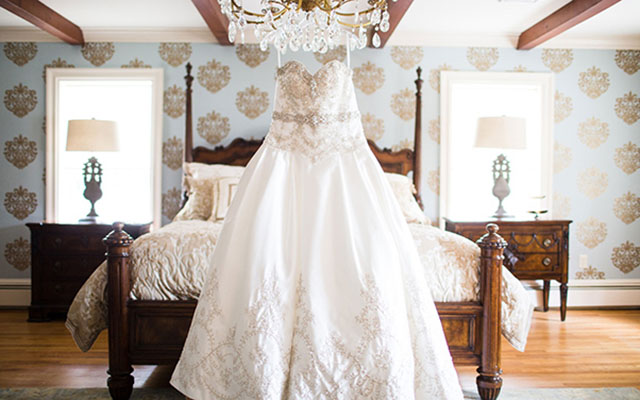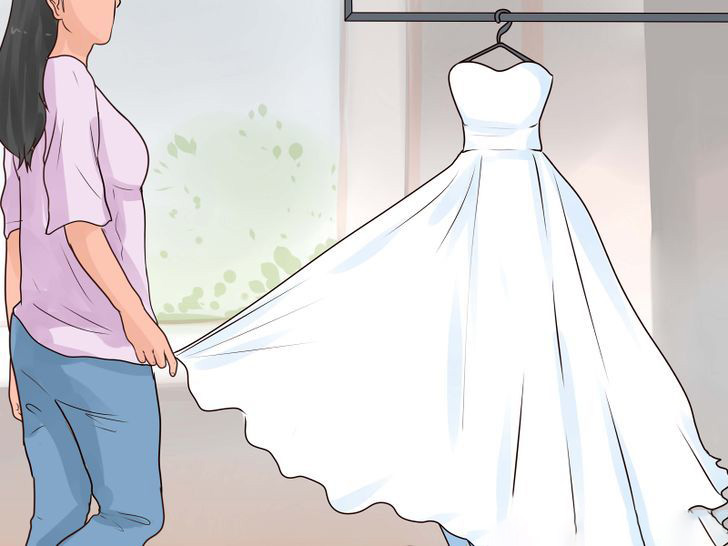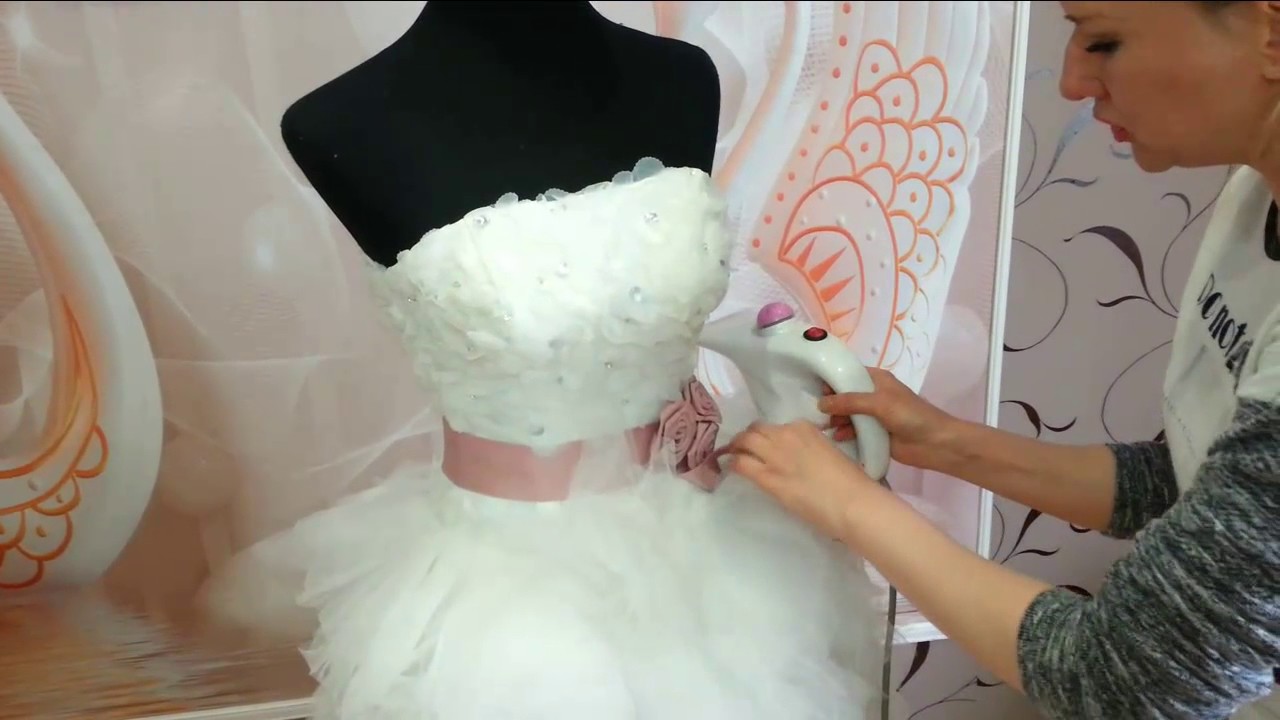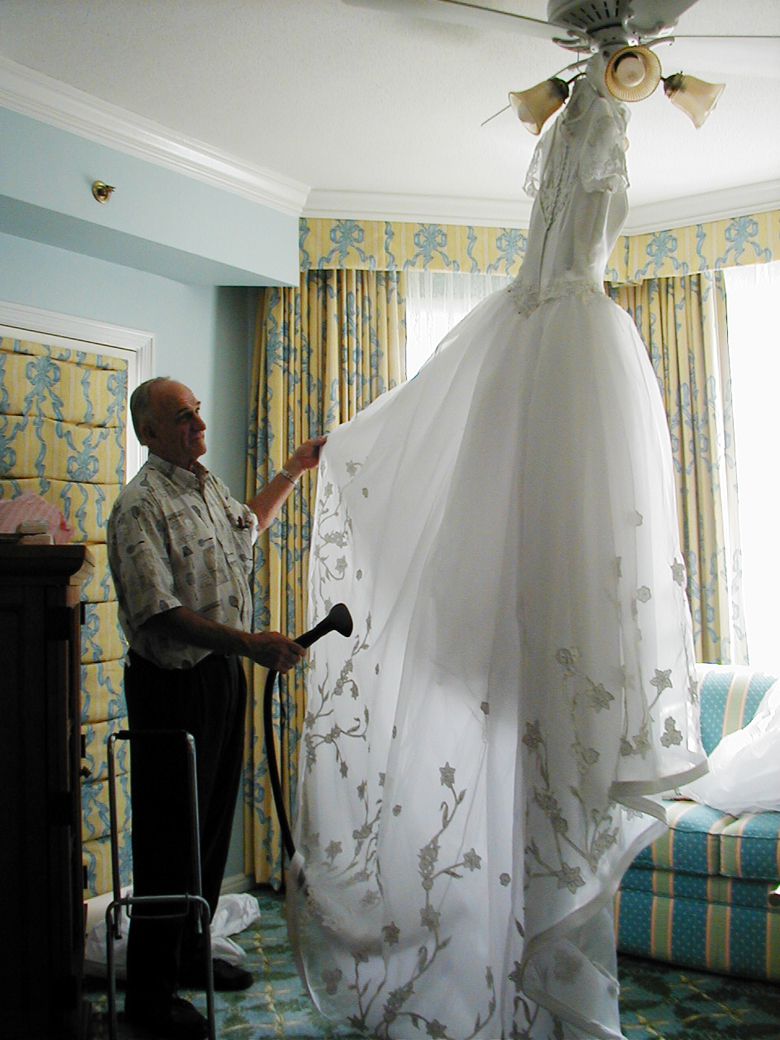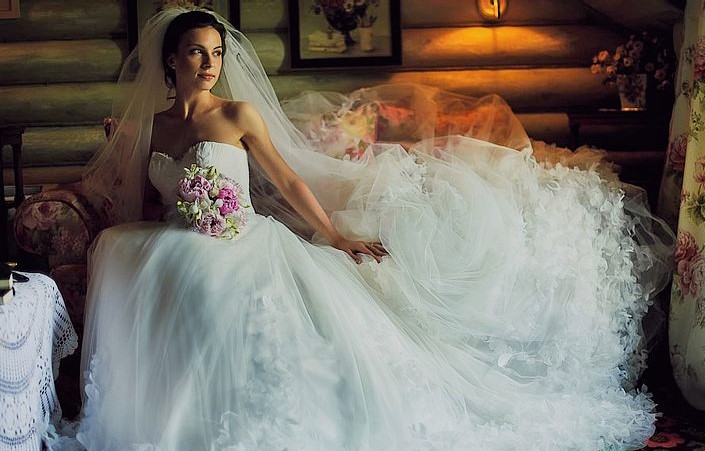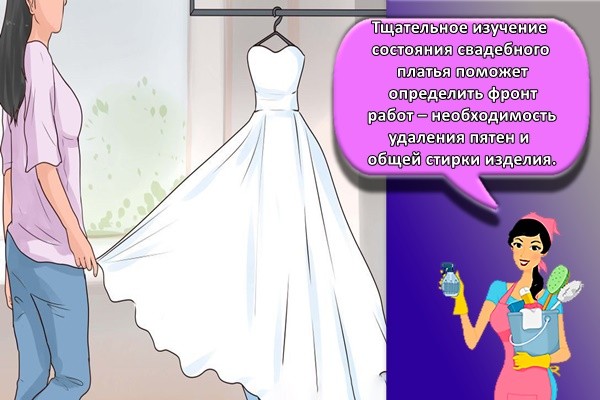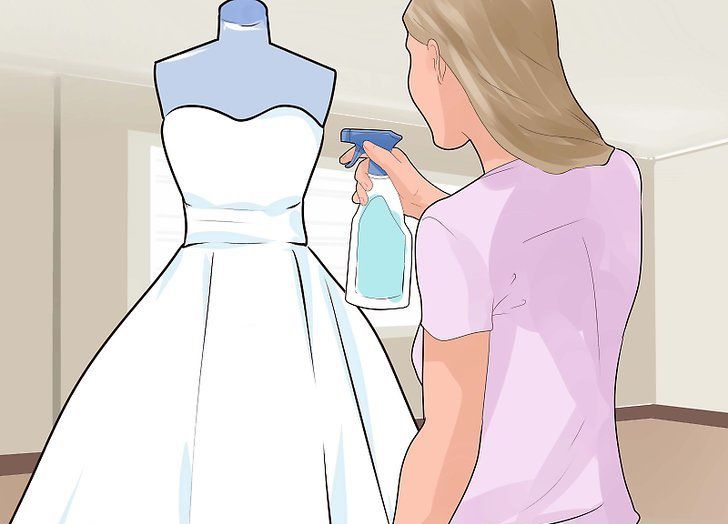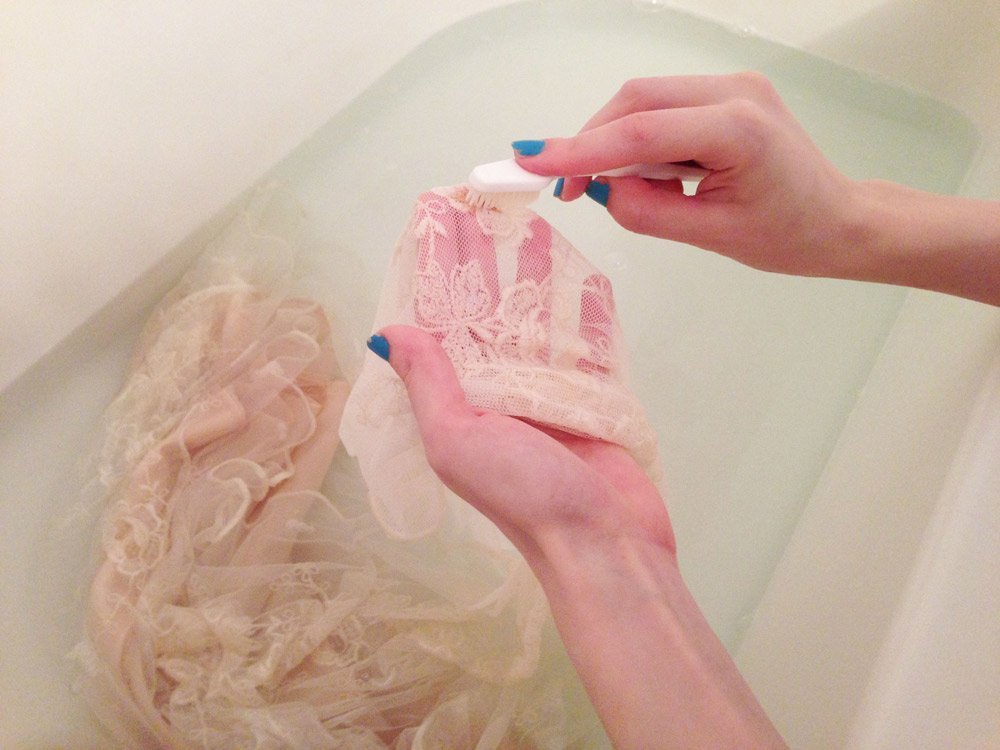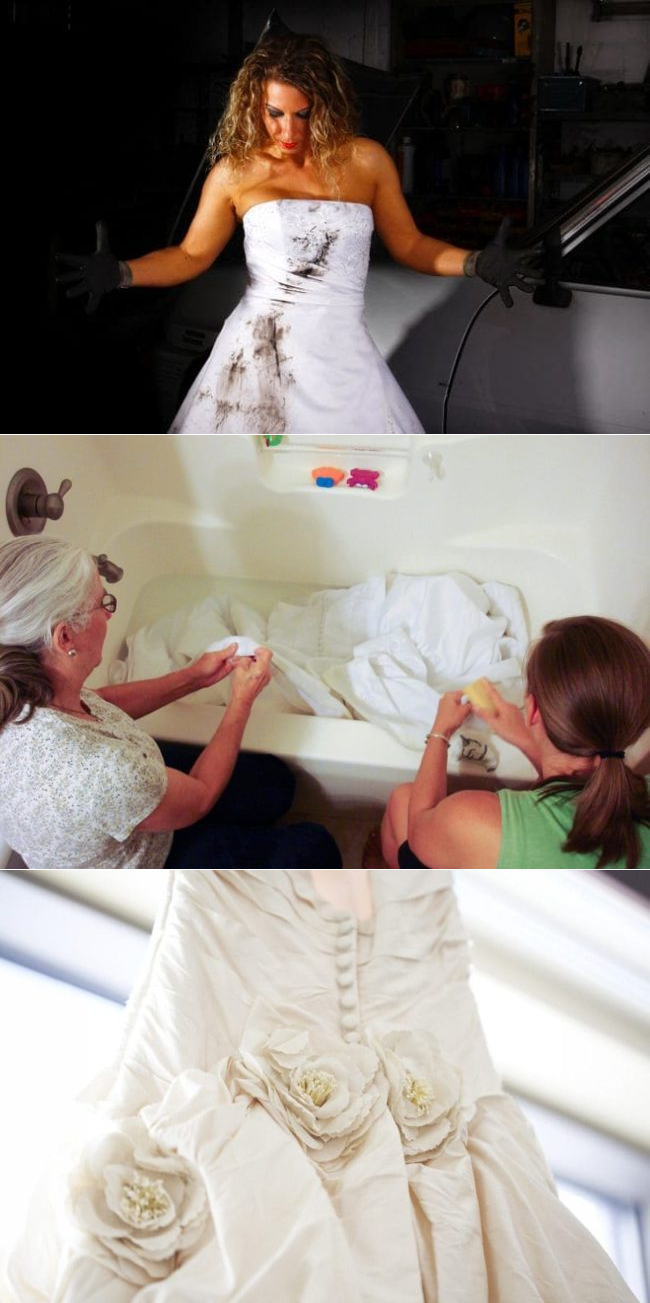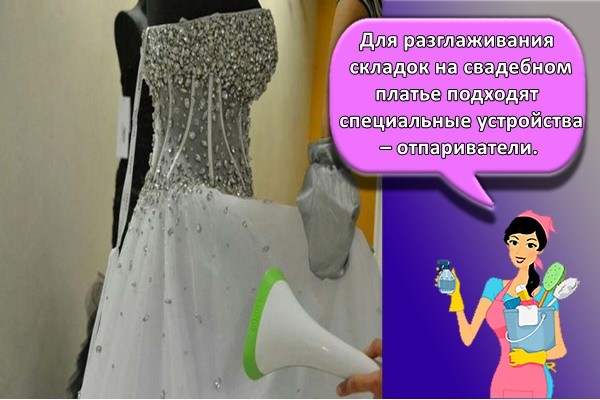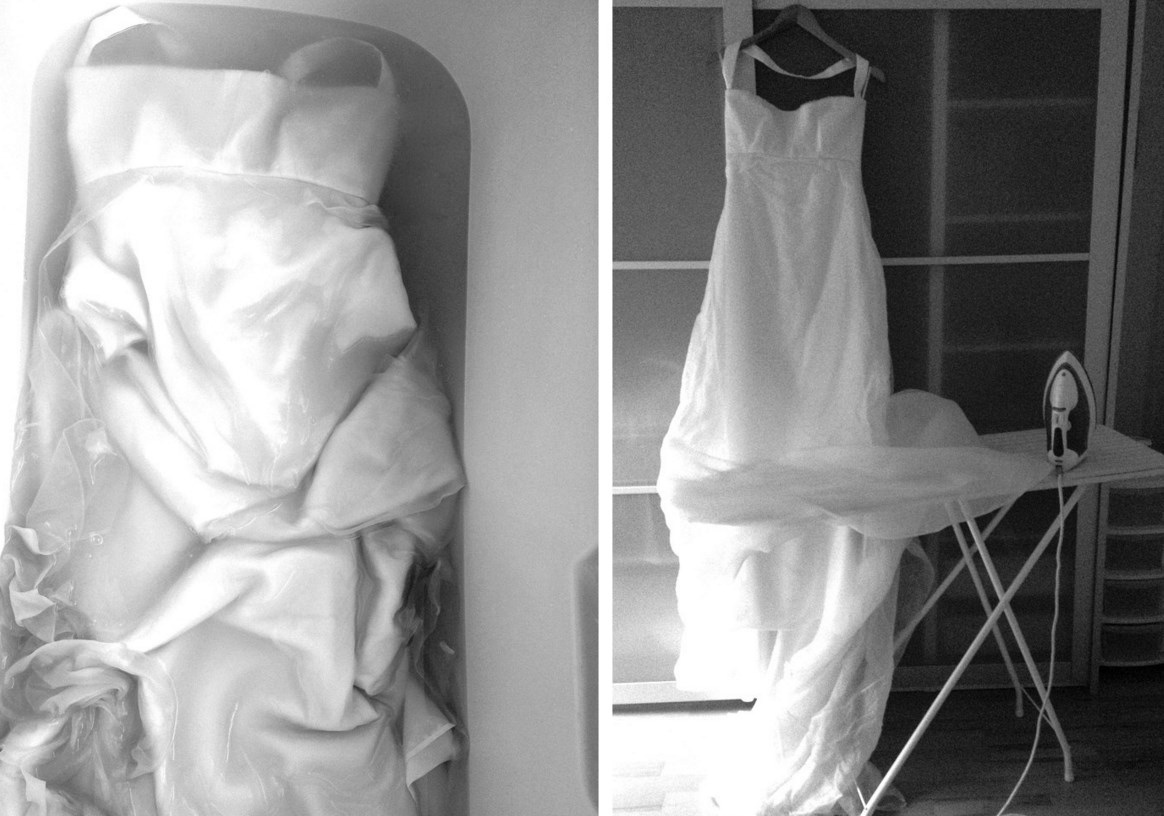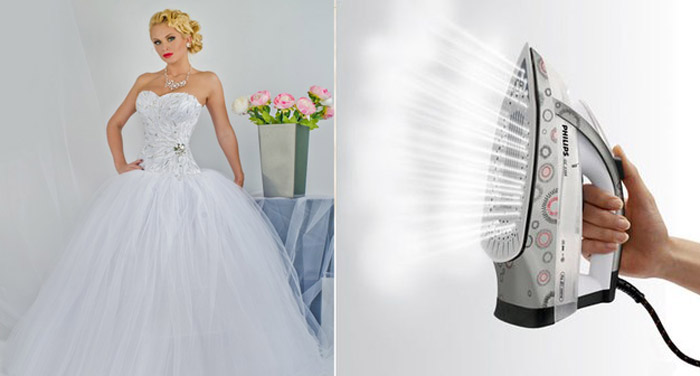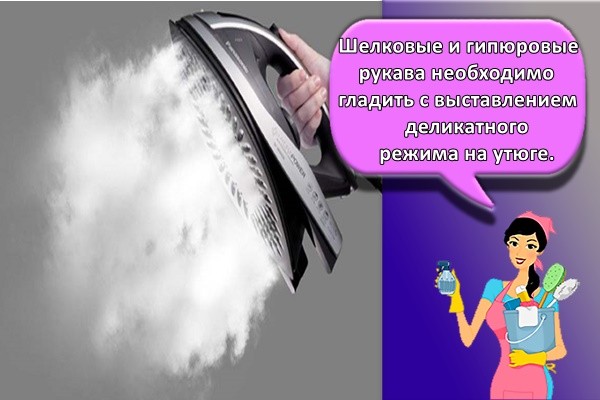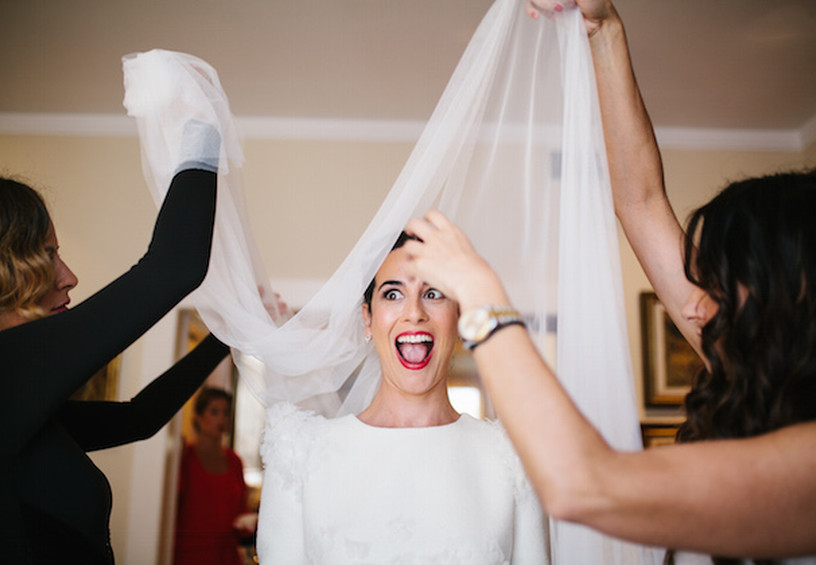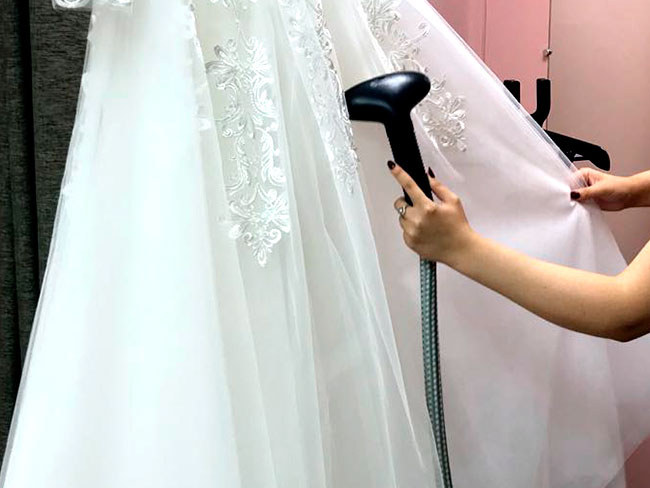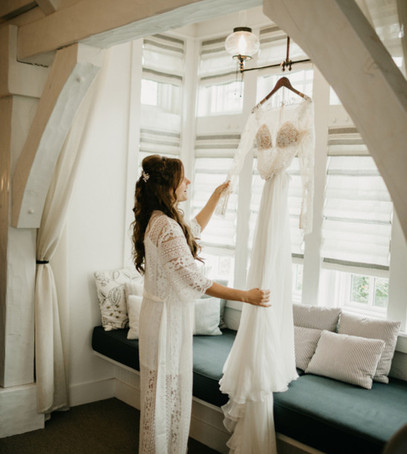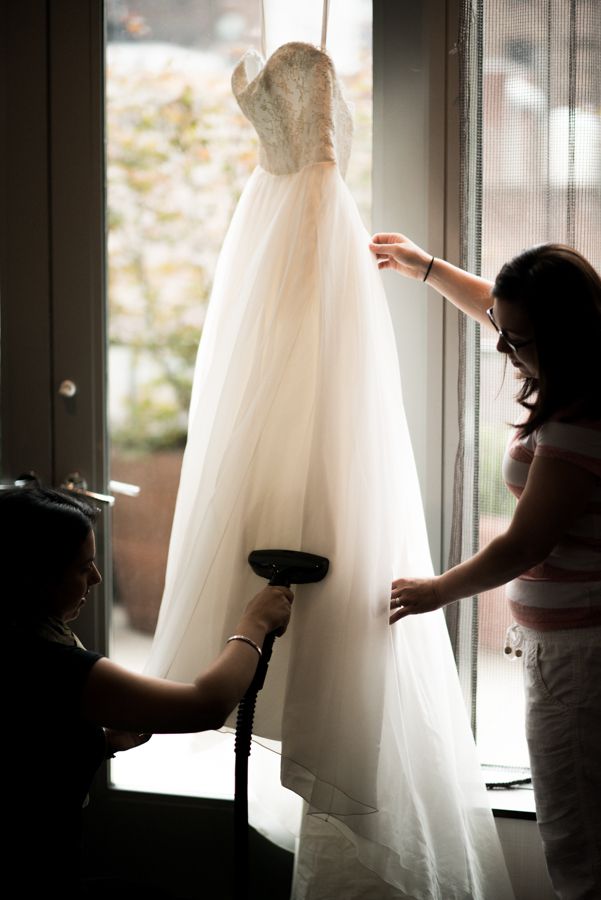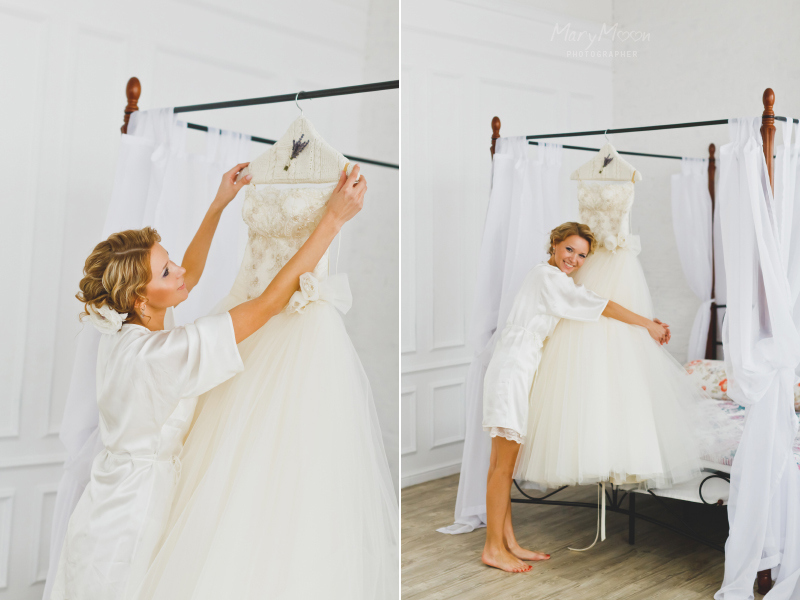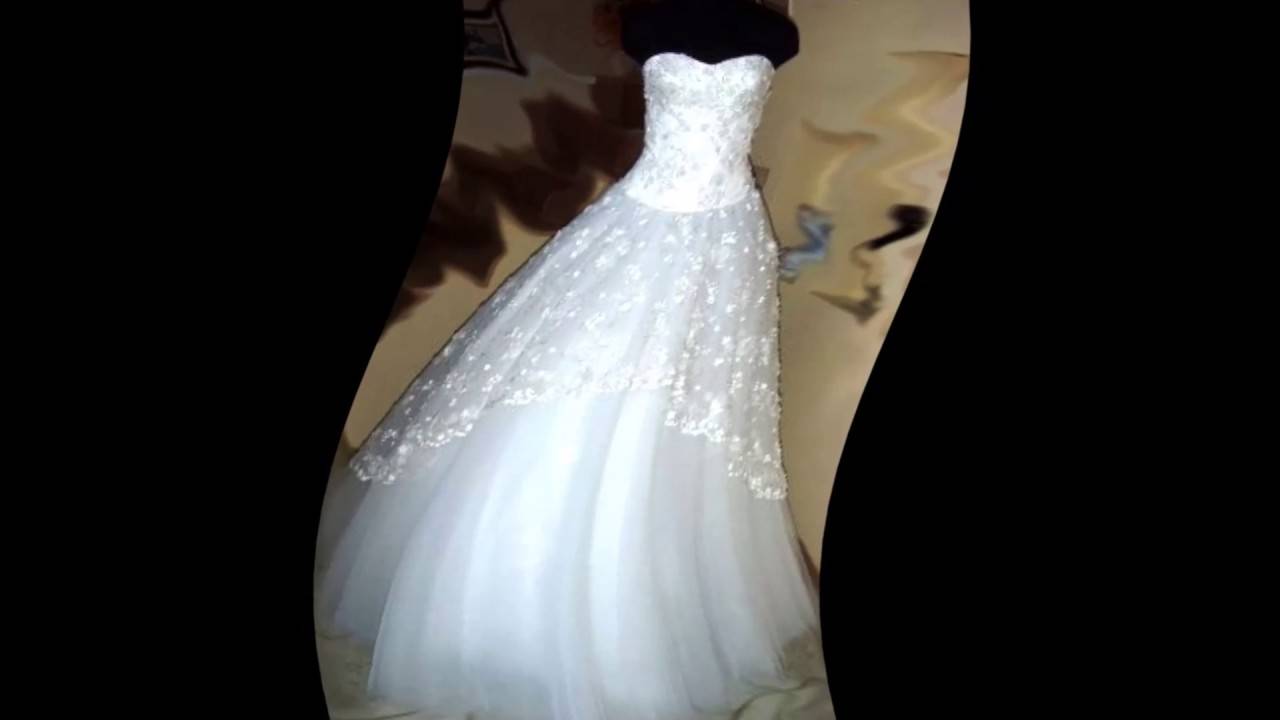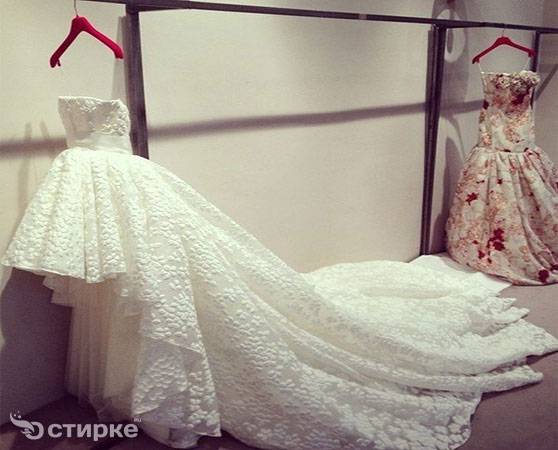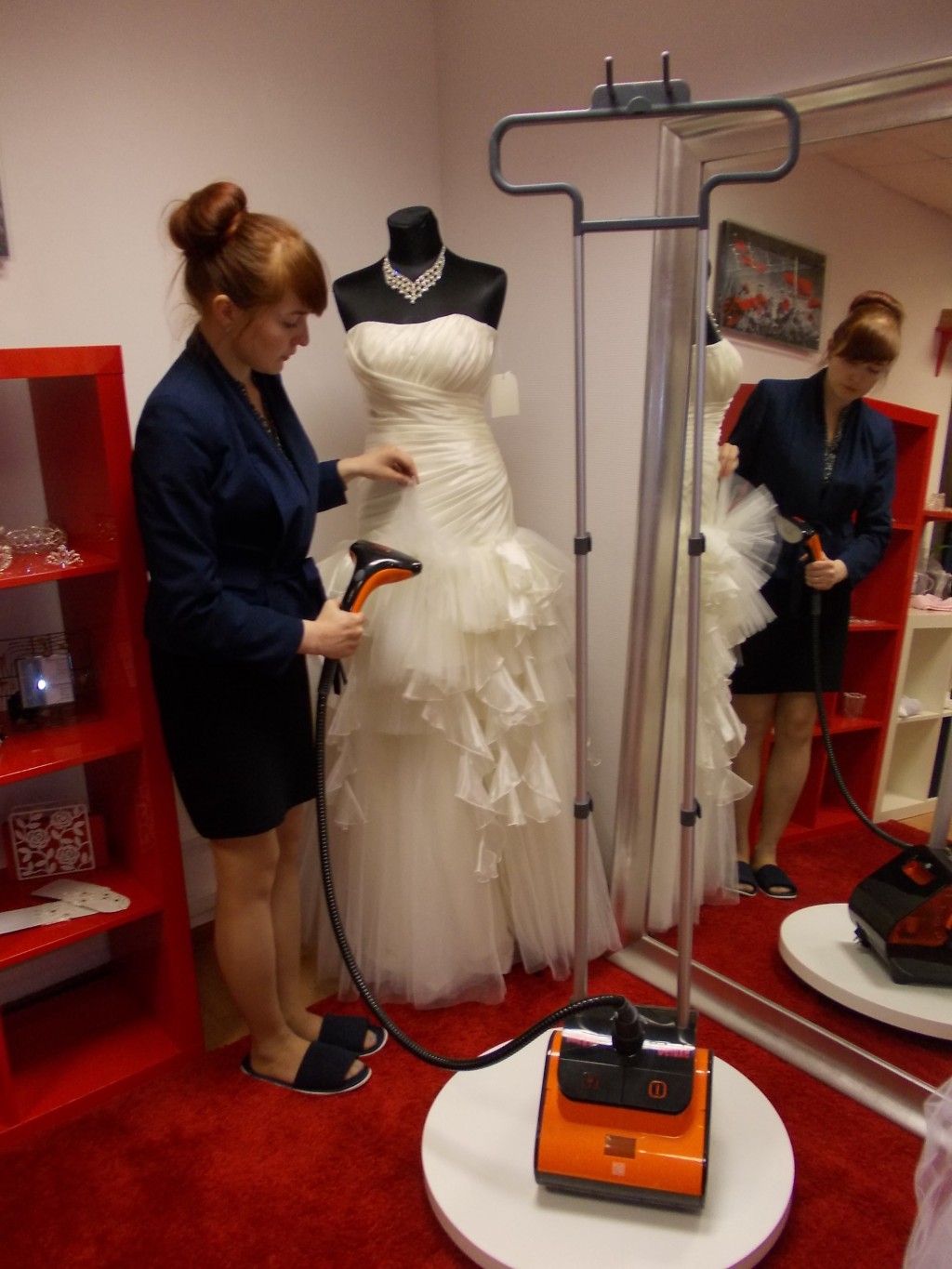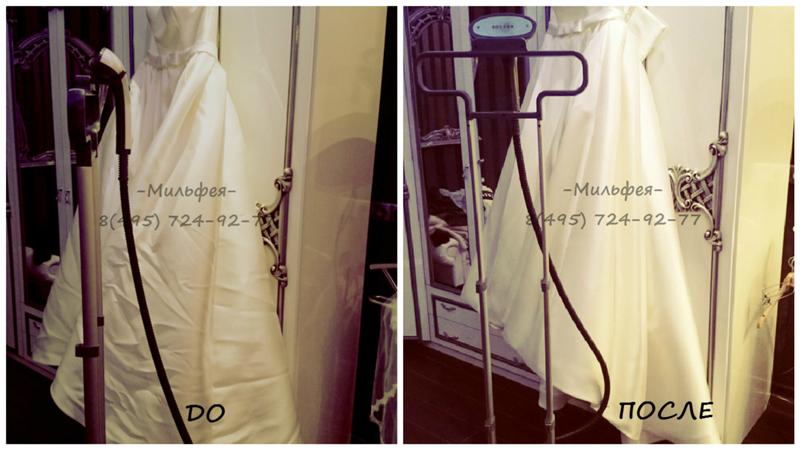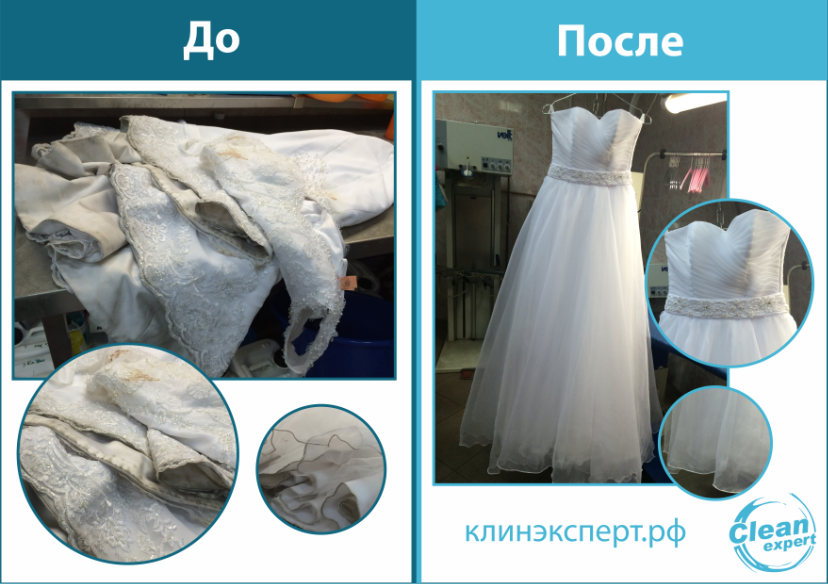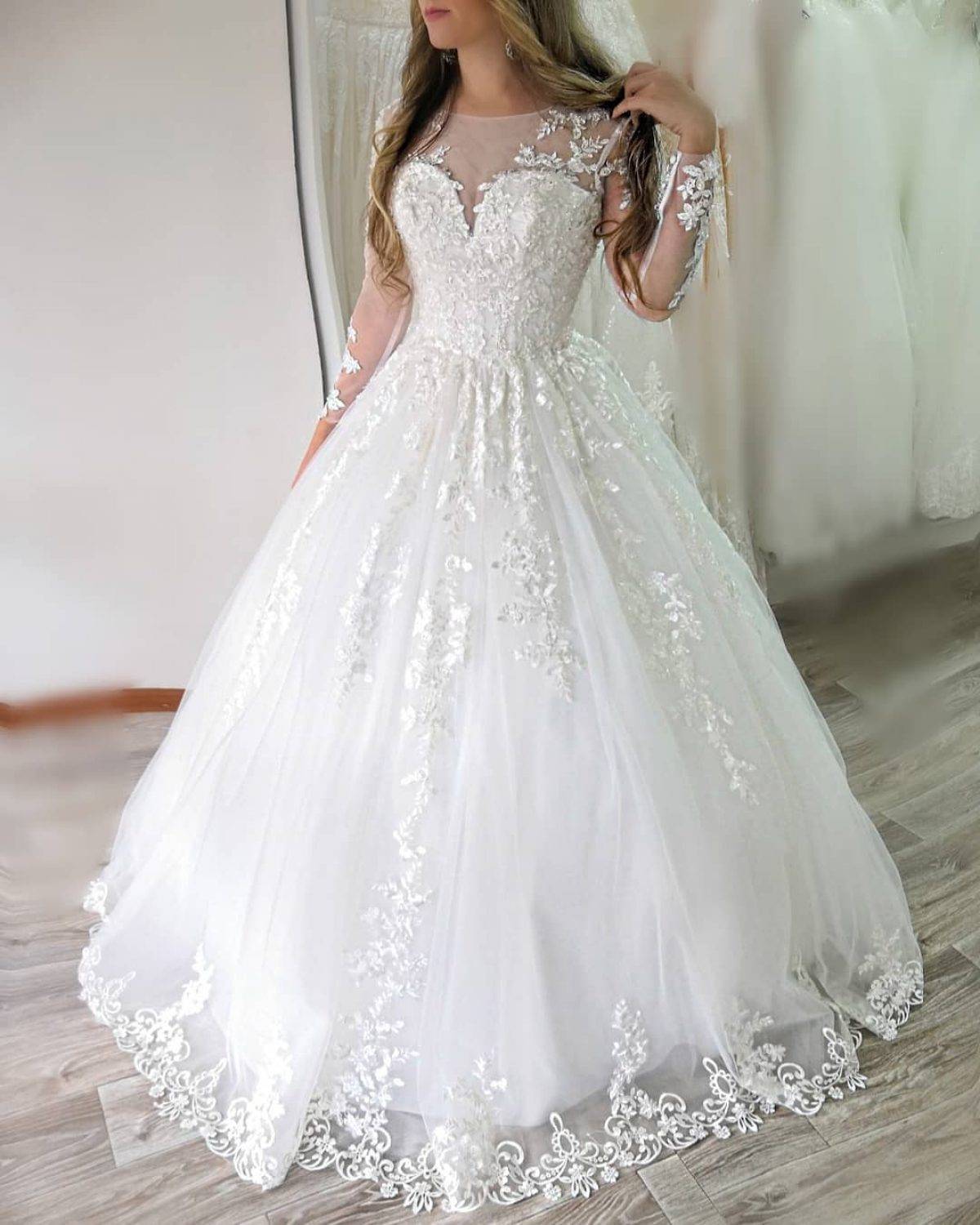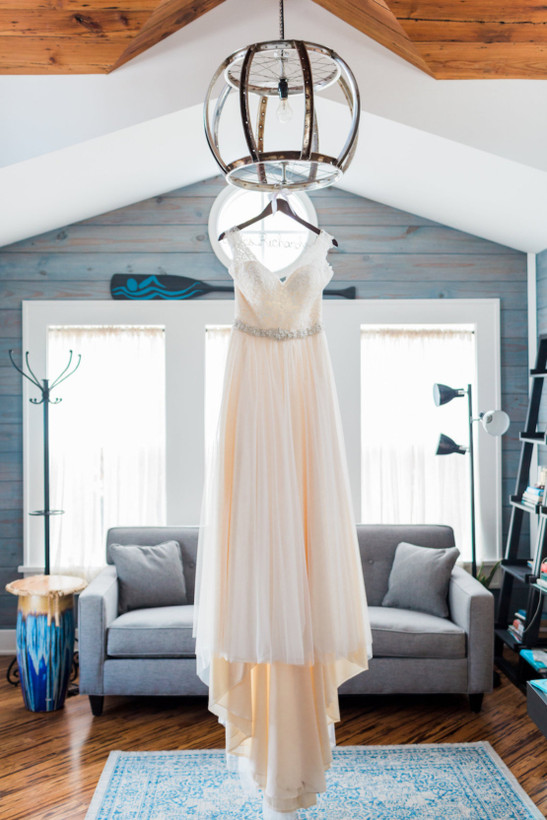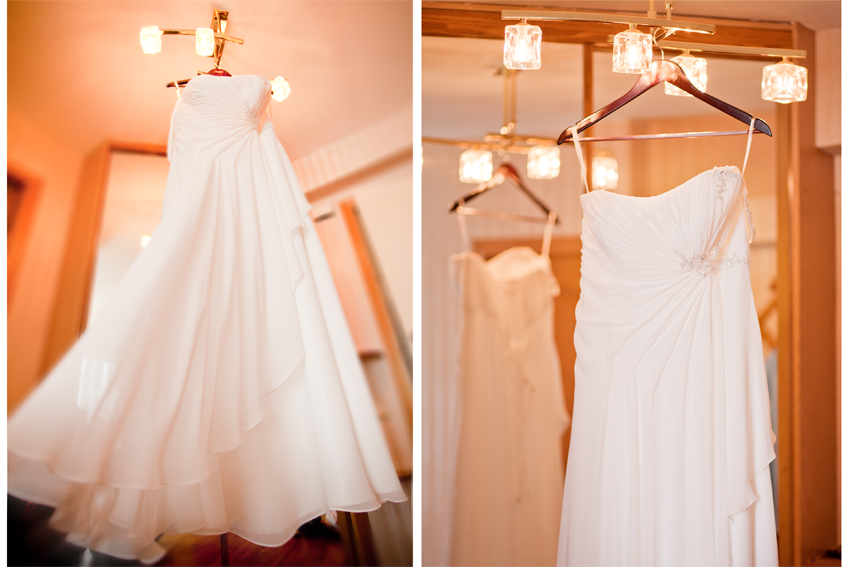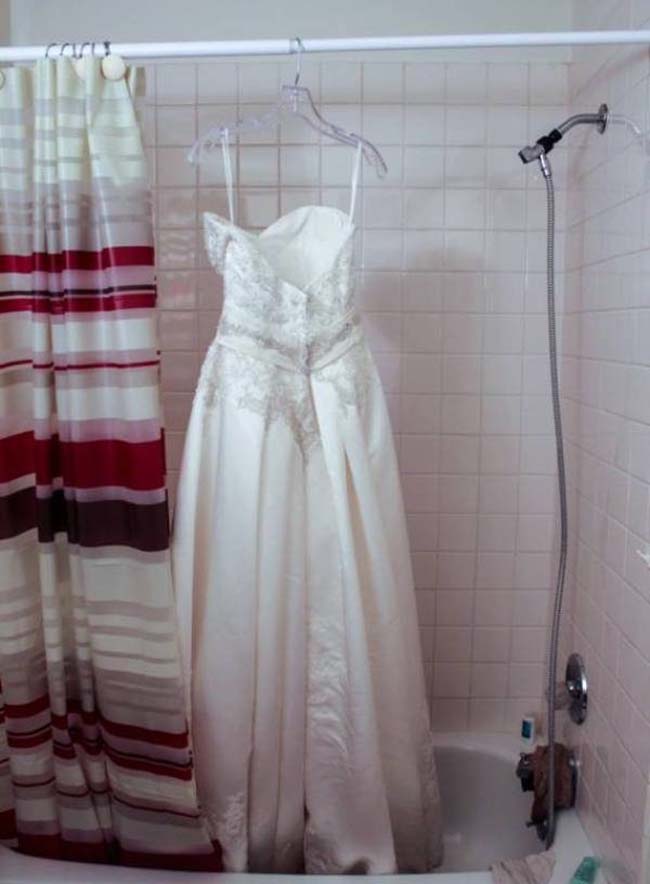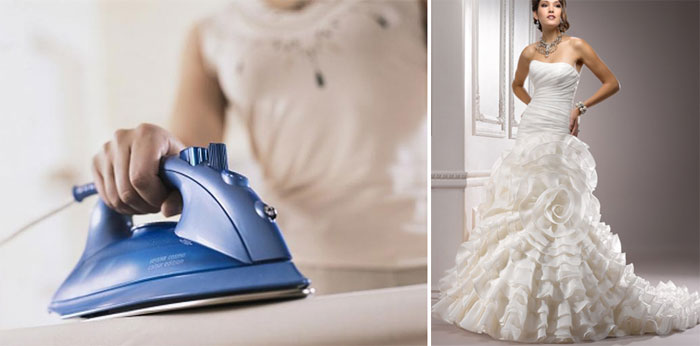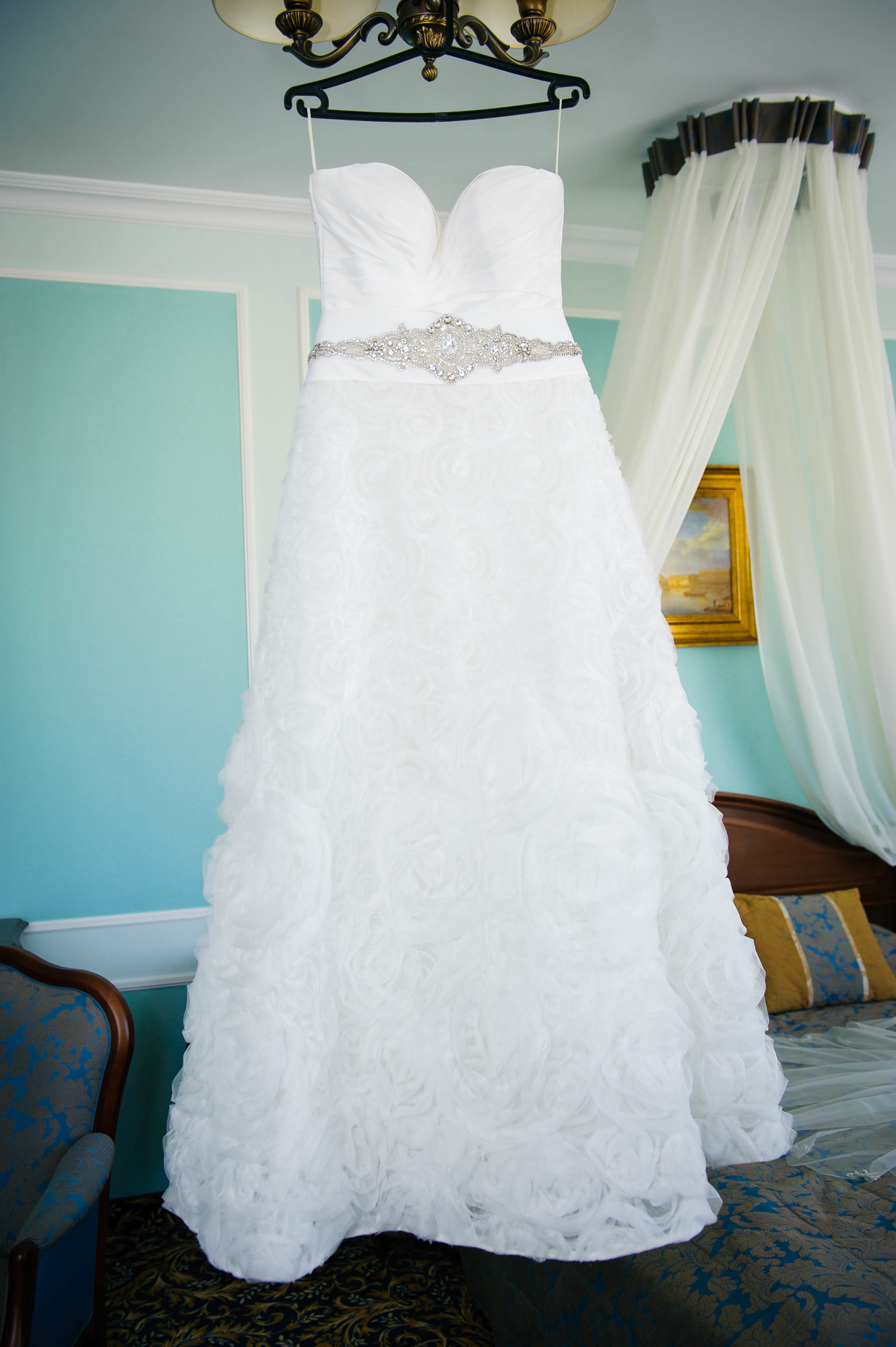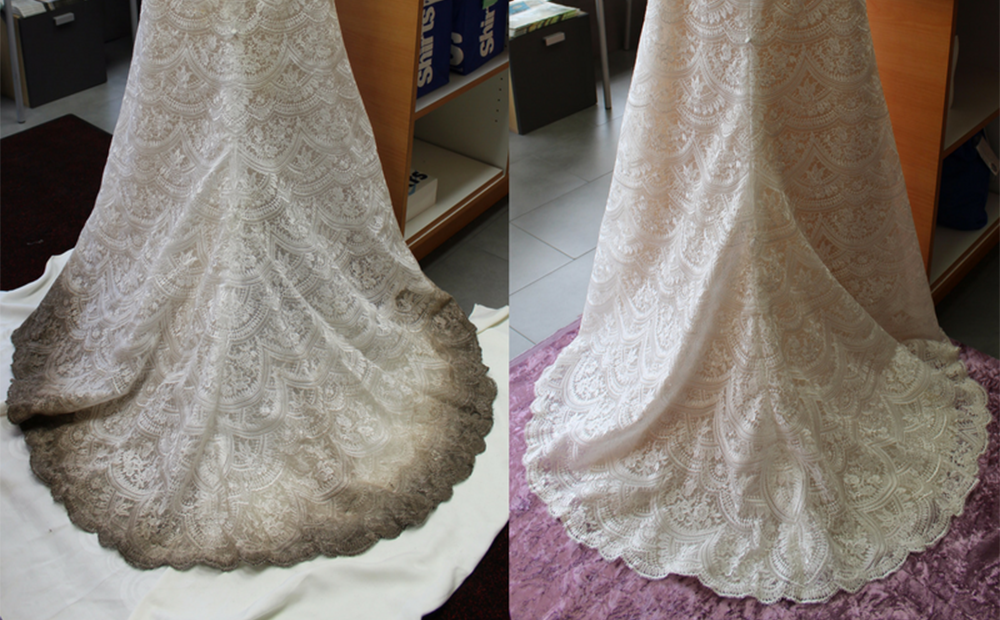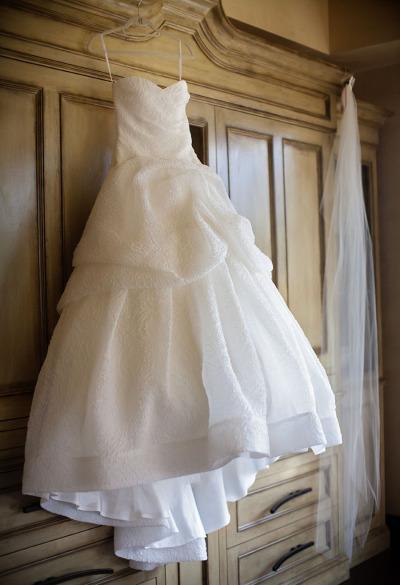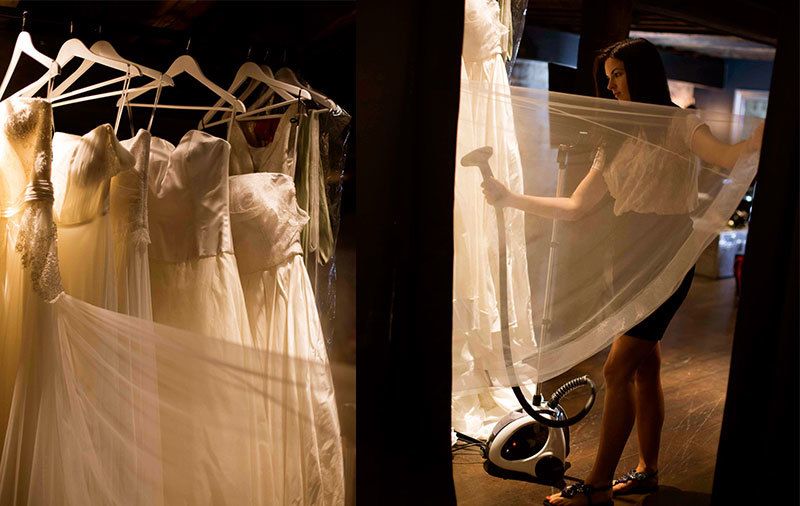Ways to solve the problem
- A boiling pot of water.
- Using steam in the bathroom.
- Ironing.
- Applying a steamer.
- Using professional services.
Boiling pan
This method is used by the most courageous girls. The procedure requires a minimum of two people. The largest container is placed on the stove, brought to a boil and the whole process begins.
The dress must be kept high enough so that it does not scald itself and spoil the fabric by dropping a part on the stove.
The disadvantages include the inconvenience of execution, as well as the danger of steaming a wedding veil in this way, in which holes can instantly appear.
Bathroom
The method is simple and inexpensive. For steaming, a whole bath of boiling water is collected, and the dress is suspended above it at a distance of about 20 cm from the water. Despite the advantages, there are a number of disadvantages:
- The material absorbs water, the clothes become heavier and at some point may fall and get wet.
- Not all kinks in the fabric will straighten out at a given temperature, the ideal effect may not be achieved.
- If the clothes are decorated with some elements, for example, rhinestones, it is possible that they are peeling off. The same goes for beads, sequins.
- Not suitable for all styles and types of dresses. Heavy outfits, as well as with fluffy skirts, cannot be processed with this method.
Ironing
An economical steaming option, but at the same time very time consuming. In this case, you will have to ask for help from a friend or mother, who will have to hold, straighten or turn it when needed.
The main cons:
- there is a risk of not guessing the behavior of the fabric at a certain temperature and burning it;
- it is impossible to iron parts decorated with beads, rhinestones, etc.
- not all tight spaces of a complex cut can be reached with a regular iron.
If you nevertheless chose this option, then read the following recommendations:
- The process begins with ironing the bodice. If it is decorated, place a terry towel on the ironing board. Then turn the clothes inside out, as this part of the wardrobe is ironed from the inside. If there is no decor, you can carry out the procedure outside without fear.
- Use water to lightly wet the creases.
- The dress should be ironed through gauze or a special mesh. Finished elements must be ironed from the inside out.
- Ironing starts from the lower skirt in a circle, then gradually moving to the top layer.
- Many ironing boards are equipped with a dedicated sleeve holder. After ironing, you need to put curled paper in each sleeve so that nothing is wrinkled.
- The train must be ironed on both sides.
- Bows, ribbons, various accessories are made from different materials, taking into account this fact, you need to choose the right temperature regime for each type of fabric.
- At the end of the work, you should definitely treat the material with an antistatic agent. Observe the recommendations on the spray distance on the preparation.
Using a steamer
The best solution to give a decent look to your outfit. The only negative is the cost. It's good if you have it at home. If not, then not everyone is able to spend 4000 rubles or more on such a thing. Although it is worth it and in the future it will help you to bring any item from your wardrobe into the desired look without any problems.
Correct use of the steamer:
- Place the outfit on a hanger.
- Fill the instrument with clean water, turn it on.
- Smooth out the uneven area by pulling it tight.
- Use the device from top to bottom, removing all wrinkles.
- After the end of the procedure, the outfit should hang to cool.
The advantages of this method:
- The speed of work. The whole procedure will take a maximum of 20 minutes.
- The fabric is obedient. All creases are removed before our eyes.
- Destruction of harmful organisms. Microbes, ticks are no longer scary, they are completely killed.
- No shiny areas like an iron.
How to wash a dress at home
If cleaning does not remove the dirt, go to wash. This method is also recommended for removing water-based stains: sweat, traces of food.
How to hand wash a wedding dress
A gentle hand wash is preferable, especially if the dress is richly decorated. If it is separate, wash the skirt separately.
- Dilute detergent or soap in water at 20–30 ° C.
- Place the skirt in the liquid and let it sit for 2 hours.
- Gently rub the dirty areas with a sponge.
- Rinse the product thoroughly in cool water, adding a few drops of vinegar.
- Dry your skirt.
The skirt or hem can be hand washed without soaking the whole dress
Washing a wedding dress in the bath
A fluffy dress decorated with sewn-on decor is best washed in the bath.
- Fill the bath with warm water, 30 ° C.
-
Add detergent, soak dress in liquid for 60 minutes.
-
Clean the fabric with sewn decorative elements by gently rubbing the dirt with your hands or with a very soft toothbrush.
- Rinse the dress until all traces of powder are removed, usually 2-3 times is sufficient.
Washing a wedding dress by weight
Wash the lace airy dress by hanging it over the bathroom.
-
Moisten the dress with warm water, after hanging it on a hanger above the bathroom.
- Wipe the dirt on the dress with a sponge and soapy water.
- Pour water over the dress from top to bottom, rinsing off the soap.
- Leave the dress hanging until the water drains.
Washing machine
Automatic washing will restore freshness to the dress.
- machine wash only thick fabrics with a minimum of decor;
- do not machine wash the corset, as it deforms;
- wash gauze or white cloth on the decor before work;
- to avoid deformation and puffs, wash the outfit in a special bag;
- soak the dress only in warm water;
- instead of powder, use a liquid colorless product to avoid streaks on the dress;
- to keep the product looking like new, add starch to the conditioner compartment;
- choose a delicate wash without spinning, at a temperature not exceeding 60 ° C.
Wash a wedding dress in an automatic machine in a delicate mode without spinning
Methods for steaming knitted products
Do not touch the product during steaming (minimum gap 10 mm)
Steaming is carried out using an iron with a steam function. The presence of the mode "wool" or "delicate fabrics" is not necessary, since direct contact with the product is not required.
If processing will be carried out on an ironing board, then check its condition - the surface must be clean. Otherwise, place a white terrycloth towel in one or two layers.

The most effective steaming methods are as follows:
- The product is taken and checked for stains. If everything is in order, then carefully lay out the item on the surface of the ironing board. We set the desired mode, moisten and squeeze the gauze. Next, the product is covered with gauze. You can run your hand to make the fabric fit snugly against the garment. Then we run the iron horizontally to the surface of the ironing board (10 mm gap). If necessary, press the "Steam supply" button on the iron.
- If for some reason there is no iron, then you can put the product in order using a household hair dryer. To do this, you will need to repeat all the same steps. Then turn on the hair dryer at maximum power and hold the thing several times. Distance 15-20 cm from the surface.
- To remove small wrinkles, you can hold the item over the steam. It is necessary to draw hot water into the bathroom. Then hang the product on a hanger over the container. Further, you only need to periodically check the thing. Sometimes we run over it with a clean hand.
After steaming, regardless of the method, the item is laid out on a flat surface and turns over every 10-15 minutes. You can put on or put away the product only after it is completely dry.
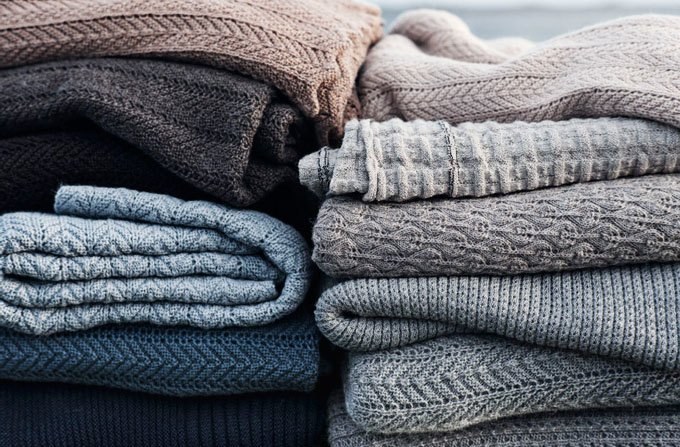
Tips & Tricks
A very simple and effective way to remove wrinkles from knitwear
If necessary, it is better not to resort to steaming knitwear and knitted products.
This is especially important for materials that are generally undesirable to wet with water.
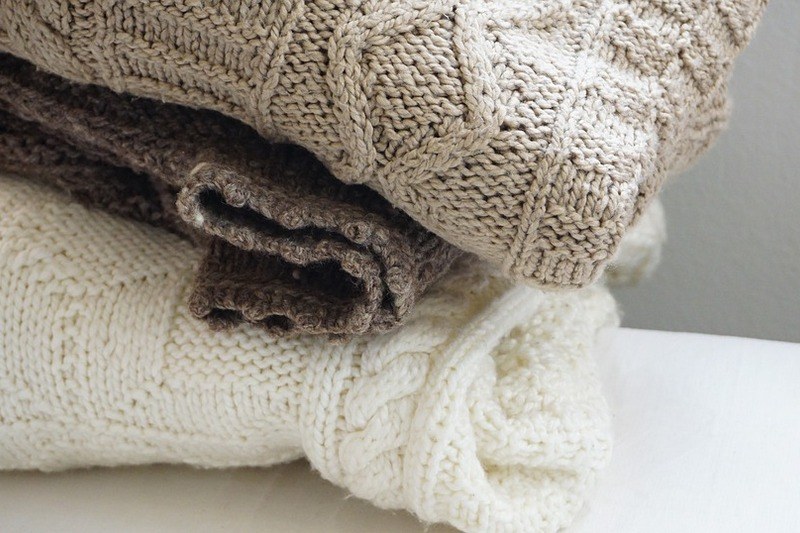
To iron knitted hats, you will need to put on a thing on any semicircular shape, for example, a glass jar and process it a couple of times with a steam generator or steamer.
White items made of cotton threads are steamed at a low temperature, as strong heat can lead to yellowing of the fibers of the material. It is also taken into account that cotton shrinks and exposure to hot steam will only contribute to this.
Silk jersey, we would not recommend steaming
Silk does not like exposure to high temperatures and, through carelessness, you can ruin the product so that it completely loses its shape and becomes unwearable.
Mohair knitwear is not ironed. For this, the method described at the very beginning is used.
You will need to boil water in a small saucepan and hold the knitting over the rising steam.
If you are afraid of ruining your knitted clothes, then you should not try and somehow experiment. Better to have your clothes dry cleaned. These are unnecessary costs, but they are clearly less than the cost of hand-made products.
Was this article helpful to you?
Poll Options are limited because JavaScript is disabled in your browser.
Preparation
You need to start cleaning your wedding dress as early as possible. If the outfit remains dirty for a long time, you will have to deal with old dirt - and this is more difficult and does not always give a result.
Exploring the shortcut
The dress should be handled as the manufacturers advise. They indicate the recommended washing and ironing modes on the labels. After studying these instructions, you need to stock up on a quality detergent, iron and steamer.
Visual inspection
A careful study of the condition of the wedding dress will help determine the scope of work - the need to remove stains (it is very good to remember what they came from) and general washing of the product. If possible, you need to remove decorative elements from the outfit that can be removed if they do not need washing.
Usually need cleaning:
- the hem of the dress (if it is long);
- the bodice on the inside, especially under the armpits, where there are traces of sweat and deodorant.
Spots can be randomly located anywhere. It is necessary to remove them before soaking, so that later the dress does not have to be re-washed.
Before wedding
The more complex the item is in cut, the richer the decor and the more fabric was used for sewing, the more difficult it is to ensure delivery from the salon (store) home and storage before the celebration.
Fundamental rules
Key rules for keeping your wedding dress attractive:
- do not rush to transport it home. The salon (tailor's workshop, specialized store) will provide the best storage conditions. If the place of purchase does not provide a storage service for the formal dress before the celebration, you should ask to pack the outfit according to the rules and tell you how to properly maintain it before the wedding;
- even if the dress was packed in polyethylene (another synthetic, air-tight packaging) when purchasing, it should be discarded for storage for more than three days. To avoid dust and accidental dirt, it is better to keep the dress in a cardboard box or cotton cover;
- when transporting in a car, it is advisable to either lay out the dress in a cover in the back seat, or fix the upper part on the car window, and the hem on the back seat. Naturally, it is not rational to carry an expensive item in public transport;
- the ideal option is to place the outfit on a special stand (mannequin) in a straightened form, under a cover or cape. If the dress is transported on a mannequin, suitable transport is required. It is better to find out in advance in the salon if they have a delivery service;
- it is better not to touch clothes made of shiny thin fabrics (natural satin, silk, velvet, brocade, lace) with your bare hands. It is even advisable to wear a dress with thin textile gloves, the same applies to assistants;
- it is undesirable to broadcast the dress in the closet, it is better to place it in an open space;
- direct sunlight or electric light on the fabric during storage for more than two days is unacceptable.
Steaming
Sometimes a dress wrinkles as a result of improper transportation or storage. To eliminate wrinkles, you need to gently steam the outfit. If the salon where the new thing was bought provides such a service - excellent, they will cope better with the task and will not damage the expensive thing.
If this is not possible, home steaming is performed using an iron (with the function of steaming at a minimum steam temperature) or a steam generator. The mode is selected with the lowest temperature and gentle effect, the dress is suspended vertically, the folds are straightened as it is processed.
If it is not possible to steam in the traditional way, you can briefly hang the outfit in a room with humid and warm air (for example, in the bathroom while taking a hot shower or bath). If materials permit, you can spray embroidery or shuttlecocks from a spray bottle.
Attention! After any treatment - steam or water, the wedding dress needs to be dried and ventilated in the shade, in the fresh air.
How to iron a satin wedding dress at home
Of course, you cannot iron a satin or silk wedding dress in the same way as other wardrobe items. This is due, firstly, to the fact that it has a huge number of ornaments and decorative elements in the form of lace, shiny beads, flounces and others that can be damaged or ruined by an iron. Secondly, many modern evening or festive dresses are made in an original and unusual way. Straightening them will take skill and patience, and this should be done with extraordinary care.
The bride's outfit, as a rule, consists of tulle, satin, lace and decorative items (beads, rhinestones, etc.). Each zone requires its own straightening technique. The procedure can end in fiasco if you do not select the correct mode or use the wrong iron with steam.
For work you will need:
- iron;
- ironing board;
- towel (soft);
- gauze (thin fabric);
- sheets of paper;
- a special device for ironing sleeves;
- steamer;
- a mannequin or hanger with a hanger.
The ironing process itself is quite complicated, so an assistant will be needed. The procedure will take about 2 hours, regardless of the size of the product.
Before starting the ironing process, satin wedding dresses must be divided into several zones. The first step is to steam the atlas. For this you need:
- Turn the robe inside out.
- On the iron, set the "two" mode and turn on the gentle steam.
- Be sure to cover the fabric in advance with gauze, better folded in several layers.
- Iron slowly, gently, helping to straighten the sides of the product with your hands.
- You need to steam each zone separately. Then let it dry for 5 minutes and then continue the process in the next section. For quick drying, you can use a hair dryer.
Then assess the condition of the bodice or corset. Both must be turned out, and also ironed, but without steam. Remember to use protective material when working with each area. If the bodice or corset is decorated with beads, rhinestones or other embroidery, then cover the ironing board with a thin clean towel.
For areas with lace, you also need to use a protective material.Through it, the fabric should be ironed several times at the lowest temperature regime that is on the device.
Crumpled chiffon, taffeta or natural silk can also be ironed with an iron at a moderate temperature, without using the steam function. For the process to be successful, it is recommended to iron a damp cloth or one that has just been washed. Most modern irons today have a special mode for ironing silk. Thus, the process will be much easier and easier.
To flatten the sleeves, use the stand found on almost every ironing board. After ironing or steaming, place the crumpled and curled sheets of paper in them. So the sleeves will retain their impeccable appearance until the appointed hour.
The device will allow you to quickly and better cope with painstaking work and relieve fears of ruining the fabric or damaging the outfit. A veil and tulle skirt should be steamed on a hanger or hung on a mannequin or hanger.
Can a wedding dress be washed at home?
A dirty wedding dress can upset a young spouse with its appearance, but you should not despair. Wanting to solve the problem as quickly and without hassle as possible, some women prefer to take wedding dresses to dry cleaners, but the results of the work of such companies are far from always able to satisfy customers.
A stained wedding dress can be washed at home
Harsh detergents and powders used to treat garments under dry cleaning conditions can sometimes seriously damage the structure of a particular type of fabric. After such processing, a luxurious wedding dress can become irretrievably ruined, turning into a Cinderella outfit.
After being dry-cleaned, the wedding dress may lose its original appearance.
In order to avoid such a situation, it is advisable to wash the wedding dress yourself, using an individual approach to various types of dirt. This will help to achieve the maximum effect, and will also guarantee the safety of your item. Provided the washing procedure is carried out correctly. On branded products, you can easily find a label containing information about the type of fabric used in the manufacture of the outfit, as well as the manufacturer's recommendations regarding washing and ironing the product.
Initially, it is necessary to inspect the dress for dirt, paying special attention to the hem, where traces of road dust are most often left, as well as to the places located under the arms, which form yellowish sweat stains. Do not forget about the inner part of the bodice, which will also need to remove dirt.
When preparing a wedding dress for washing, the type of material from which it is made is of particular importance. In most cases, in the manufacture of this kind of outfit, synthetic fabrics are used, which involve hand washing.
A branded wedding dress must have a label with recommendations for caring for it
Since a variety of decorative elements in the form of beads, rhinestones and beads are used as decorations for wedding dresses, you should be very careful with them during washing. In some cases, glue is used as their fasteners, due to the presence of which the rhinestones can easily fly off. If this happens during the wash, do not despair too much. Floral patterns can be restored by hand using threads or specialized adhesives.
Richly decorated bodice of a wedding dress
With an iron
Smoothing a wedding dress with an iron is an economical option and very time consuming. Ironing yourself is difficult, you will have to ask your mother or friend for help.
Do not iron parts decorated with beads, rhinestones or sequins.
Everything will go smoothly if you follow simple instructions.
In addition, if you are using a steamer, no help is required.
How to iron the dress correctly:
- If stains are found, it must be washed.
- Ironing begins with the bodice. This part of the outfit is usually decorated with various decorations, so the process is carried out from the wrong side. If there are laces on the back, remove them. If the bodice has a zipper, open it. The bodice without decor can be ironed outside.
- Creases and creases should be moistened. This will make it easier to smooth them out. Fill a spray bottle with distilled water and spray as needed.
- Ironing is done through cheesecloth. The soleplate of the iron should not be applied to delicate fabrics, you can burn a hole.
- After ironing the bodice, move on to the petticoat. If there are several of them, process them one by one. The top layer is smoothed last.
- If there is a train, iron it on both sides. Use a cheesecloth slightly dampened with a spray bottle.
- The work ends with the treatment of the outfit with an antistatic agent. Read the instructions for its use and spray at a distance of 20-30 cm from the dress.
Consider the material from which the dress is sewn. Perhaps it is sewn from several fabrics, which means that the temperature on the iron will have to be constantly adjusted so as not to spoil the outfit.
After you finish ironing, do not put it on the bed. Hang on a coat hanger. You can't go into the closet. The dress will wrinkle again. It is good if there is an opportunity to hang it in such a way that there is nothing in a few centimeters around it, no one walked there.
Chiffon
Chiffon wedding dresses are ironed at a temperature of 60-120 degrees. There are programs on modern technology that have already been adapted to the required material. Just select the "delicate" or "chiffon / silk" mode, calmly iron the necessary places.
Dresses made from this material look great if they are ironed correctly.
This fabric also deteriorates easily if you turn on the wrong ironing mode.
It is not recommended to use steamers for wedding dresses made of this material. Usually, the manufacturer indicates this information on the label.
It is much easier to iron clothes when wet. Use a spray bottle, just don't overdo it. If you wet it too much, it will take longer to iron, and the hot temperature damages the material with prolonged exposure.
Before ironing, turn the garment inside out and place it on the ironing board. The iron should glide smoothly from the center to the edges, thus avoiding the formation of creases on the material.
Atlas
Satin fabric does not need much maintenance. Perhaps, dresses made of such material are the easiest to iron and steam.
How to iron a wedding dress made of this fabric:
- Atlas cannot be ironed at temperatures above 150 degrees. It should be processed exclusively from the wrong side to maintain the shine and unrivaled appearance of the material.
- We recommend using a cotton cloth for ironing. You cannot apply the iron soleplate of the iron directly to the fabric if you do not want to damage it on purpose. In addition, the cotton fabric will protect the satin from shining.
- Do not iron dry satin. Before the procedure, it is well moisturized.
If, for some reason, an iron mark remains on the outfit, soak a cotton cloth in a vinegar solution and apply it to the problem area. Then steam the area with the iron, but do not iron.
Lace
Lace inserts should be starch with a weak solution of potato starch. Mix 2 tbsp in a container. l. funds and 5 liters of water.
This composition starch the product, then dry it a little, after which you can start ironing
The procedure is carried out only with the tip of the iron, carefully moving it over the fabric
The lace should be ironed very carefully so as not to create creases and creases at the edges. Watch your movements carefully, the tip of the technique can break the material.
Ironed and starched fabric looks better than steamed fabric.
Method 3: iron
You can smooth out unnecessary folds on the dress using an iron with vertical steam: fix the dress on the hanger, direct a stream of steam onto the crumpled fabric, but do not bring the iron close to avoid damaging the material with a too hot stream.
And if the fabric still did not straighten out during steaming, how to iron a wedding dress in this case? You will have to resort to traditional ironing with an ordinary iron. Do not be afraid - if you do everything correctly, you can iron your outfit at home no worse than you would have done it in a bridal salon.
Our tips will help you to properly iron your outfit:
Place the PTFE pad on the sole of the iron. There is no such thing - iron through a thin cloth or gauze, folded in several layers.
The surface of the iron, like the ironing board, must be perfectly clean!
Choose the temperature to match the type of fabric. If you can't perfectly iron some part of the dress, apply steam, but at the minimum setting. Or, dampen the fabric you are ironing through, but it shouldn't be too wet.
First, use the tip of the iron to iron the dress on an inconspicuous area. If the fabric is not wrinkled or melted, continue ironing in the same mode.
Do not forget that an outfit is most often made from several types of fabric, so constantly change the heating temperature of the sole. For example, satin is perfectly ironed (through the fabric in all cases!) With steam on the "two", organza will withstand only dry ironing on the "one".
The smoothed folds of the dress must be held so that they do not wrinkle again, so while ironing, take your friend, mother to help you.
Ways to steam a wedding dress at home
You can give the wedding dress to the professionals to steam, but more often this does not require a lot of effort, because it is easy to put it in order on your own. There are several ways to steam any fabric:
- Using a saucepan of boiling water.
- Hold over steam.
- Iron.
It is better if you agree with the wedding salon where you made your purchases so that the outfit should be steamed right before the celebration. All wedding salons have special steamers for clothes, so some even provide this service free of charge or for a nominal fee. But the dress still needs to be delivered home, and on the way it will still wrinkle. Sometimes one hanger is enough to let the outfit hang, but more often the wedding dress needs to be steamed again. Don't worry: follow our instructions and you will succeed.
Using a pot of boiling water
Some resourceful girls resort to this method: they boil water in a saucepan, and then, with the help of a second person, steam the problem areas of the wedding dress. The veil is steamed in the same way, just be very careful, because the veil consists of a material in which the steam will quickly make a hole or the fabric will shrink to such an extent that it cannot be restored.
Hold over steam in the bathroom
Some brides pour very hot water into the bathtub, which produces a lot of steam. First, hang your wedding dress on a hanger above the steam (so that the hem is 20-23 cm from the water). Then the fabric from the humid air gradually begins to smooth out and straighten. But there are several risks associated with this method of steaming:
- firstly, the outfit sometimes falls into the water;
- secondly, if there is a decor - sequins, rhinestones, beads that are glued to the fabric - the jewelry can come off under prolonged exposure to moisture;
- thirdly, there are fabrics that cannot be steamed in this way.
With an iron and gauze
For some reason, girls are afraid to iron a wedding dress with an iron, but there is nothing wrong with that. The main thing is that the dress or veil should be ironed through gauze, and not directly. If you do not use a thin fabric when ironing, then the bride's outfit can be easily ruined.The stores sell special fabrics for such cases, through which any materials are ironed, so if there is no gauze in the house, then there is always a way out. To iron your wedding dress you will need:
- iron;
- ironing board;
- gauze or thin white cloth;
- water spray.
It is advisable that when the wedding dress is ironed, someone is present to hold, straighten and rotate it. It is very difficult to iron a fluffy skirt alone. We set the temperature to one, maximum to two. It is better not to use steam, but if the fabric does not flatten at all, then it is allowed to turn on the steam to the delicate mode. Dry gauze should be folded in 2-3 layers, put on the dress and lightly ironed. If the result is visible, then feel free to continue the process, if not, then the temperature of the iron should be slightly increased.
If the wedding dress contains different fabrics, then the iron should be adjusted for each specific material. For example, an atlas should be ironed on a deuce and use the steam function. And it is advisable to iron the organza on a unit, and it is not recommended to use steam at all. Do not forget to use gauze in all cases! When ironing the veil, first try to iron only the edge to make sure the material does not deteriorate, and then proceed with the full ironing. So the rules are:
Start ironing the bodice first. If there are decorative elements, then place a terry towel on the ironing board first, and iron the bodice from the inside. If there are no chains, locks, rhinestones or lace on it, then feel free to iron the bodice outside.
A special stand on the ironing board is provided for ironing the sleeves. In order for the fabric to be smoothed out on the sleeves, a slight pressure of the iron on the desired area is enough. To avoid wrinkling the sleeves after ironing, place curled sheets of paper in them.
Bows and ribbons are usually made from different types of fabric, so adjust for each accessory separately.
The greatest attention should be paid to the skirt when ironing: start from the bottom layer using gauze, setting the delicate mode, and end with the top layer of the skirt.
Video tips for performing the procedure at home
It is easy to get rid of the folded folds, straighten the ruffles and frills, and tidy up the fabric at home. Experts will tell you how to steam at home a wedding dress just brought from the salon in the video:
How to iron and steam a wedding dress
It is always recommended to use the appropriate temperature setting for the particular fabric.
Table: type of fabric and method of steaming
| Type of fabric | Steaming method |
| Atlas | dry ironing without steam from the inside of the dress. |
| Lace |
|
| Tulle embroidered with decorative elements |
|
| Chiffon |
|
Steaming methods
The dress can be steamed at home in a variety of ways.
- iron;
- over steam in the bathroom;
- hold over a saucepan of boiling water;
- steam with a steam generator.
How to iron a wedding dress
Here are some valuable tips for properly ironing your wedding dress:
- Wipe dust off the ironing board and cover with a blanket.
- Clean your iron as needed. Do not put water in it.
- Iron the product, when it is still slightly damp, through cheesecloth or cotton cloth.
- Choose a suitable temperature setting for the fabric from which the dress is sewn. Start ironing at a low temperature (for silk): if the fabric starts to stick to the iron, reduce the temperature.
- Do not use steam functions.
- If the wedding dress is made of several fabrics, switch the ironing mode each time for the specific material.
- Iron the product with accessories only from the inside out, with a terry towel underneath.
- Iron the laces through the fabric, and the long sleeves on a special stand.
- Start with a hem or train.
- Hang the dress on a hanger so that the skirt rests on the board and iron it carefully.
- Treat the outfit with an antistatic agent, hang it on a hanger and straighten the folds.
Steam bath
Steam treatment is better than ordinary ironing in that it refreshes and preserves the presentable look of the outfit for a long time, eliminates washing marks. Do not iron a chiffon and tulle wedding dress with an iron, it is better to steam it while hanging. The method of steaming in the bathroom is laborious, and sometimes even risky: the glued decor comes off, and the outfit falls into the water.
- Pour hot water into the tub.
- Hang the dress over it, stepping back from the water at least 20 - 30 cm.
- Be careful not to let the dress fall into the water.
Steaming with a pot of boiling water
The popular way of steaming a dress is effective, but an assistant is required to hold the dress. Be careful to avoid burns. The disadvantages of this method are that the process is tedious and long. You may have to boil more than one pot of water in order to steam the entire dress. In addition, all this time the dress must be held in hands.
- Pour water into a saucepan and boil it.
- Place on the floor with a sturdy thermal support.
- Take the dress in your hands and hold it over the boiling water, twisting as you smooth out the wrinkles.
Steaming with a steam generator
The modern steam generator smoothes creases without contact: just hang the dress on the hanger. With the device, the steaming process becomes quick and convenient. The principle of operation is the smoothing effect of steam on crumpled fabric. Read the instructions carefully before using the device and observe safety measures. There are several advantages of this method:
- no ironing board is needed for steaming;
- the fabric takes shape and elasticity under the action of steam, without being damaged;
- constant steam supply is provided;
- creases even in hard-to-reach places are straightened.
Steam generator application method:
- Place the dress vertically.
- Fill the steam generator with water.
- Steam the large parts first, and after the sleeves, the corset, the skirt.
- Do not put on the dress immediately after steaming, but leave it hanging on the hanger.
A steam generator will help you quickly and easily steam a wedding dress
Two ways to hand wash
How to wash a wedding dress at home if only the long hem is dirty?
- You will need to fill a wide basin with warm water, pour 2 caps of liquid powder into it, or prepare a soapy solution.
- Hang the dress over the pelvis and soak the hem in the liquid. Leave to soak for 2 hours and then wipe with a soft sponge, and brush the edge with a toothbrush.
- Thoroughly rinse the lower part of the decoration, wait for the water to drain. Hang dry in a well ventilated room.
How to wash a fluffy ball gown with rhinestones that cannot be ripped off before washing?
You need to collect water heated to 30 ° C into the bath, pour in the right amount of detergent and carefully immerse the outfit there.
Soak for 1 hour, rub the places where dirt accumulates with your hands, gently clean the cloth with rhinestones and release soapy water.
It is necessary to rinse the thing at least 3 times, this is the only way to completely remove the powder.
If a girl is growing up in the house who attends a dance school, there are many chic outfits in her wardrobe. After the next performance, mothers begin to tidy up the clothes and look for a way to wash the fluffy children's ball gown.
- To wash a lace airy wedding or ball gown without heavy accessories, it does not need to be soaked in water.
- Place it on a hanger above the bathtub and wet it with shower water.Scrub the fabric with a gentle sponge soaked in soapy water and remove the stains using the methods described above.
- Rinse off the detergent with a shower hose from top to bottom. Try not to stretch the outfit so that it does not deform.
Regardless of what method of washing the dress is chosen, it is forbidden to twist and wring it out.

